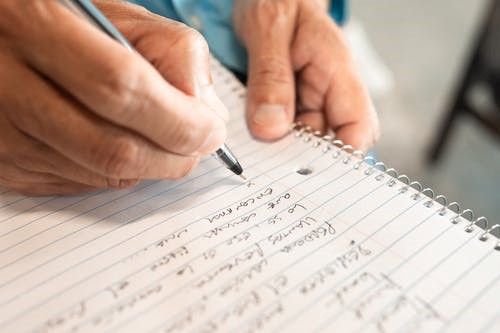How to Write a Chemistry Lab Report
Chemistry is the study of matter and how it interacts with other substances. Chemistry Laboratory Reports are often used to analyze chemical reactions, test hypotheses, or explore scientific questions.
A Chemistry Lab Report can be written using different formats depending on the type of experiment being conducted. For qualitative experiments (i.e., those not involving exact measurements), a lab report may consist of an introduction paragraph, procedure section, conclusion section, and references list.
Quantitative experiments require more specific information, such as graphs or tables that present data in numerical form.
What are the Different Parts of a Lab Report?
The structure of a chemistry lab report includes the following parts:
| • Abstract • Background information • Introduction • Materials and methods • Results • Discussion • Conclusion • References |
Abstract
The abstract describes the experiment and its major findings. It is a short paragraph that serves as an overview of the experiment. An abstract can be written at the beginning or end of the actual lab report. The abstract consists of four essential elements:
| • A brief statement of the experiment results • The study objectives also called the purpose of the experiment • A brief statement of the methods used in the experiment • A statement of the conclusions and discussions |
A background information section
The background information describes any relevant knowledge gained by previous studies. It includes prior research, theory, and observations necessary for readers to understand the experiment and its significance.
Background information may be summarized in one or two sentences, depending on how much has been learned about the topic through research. The background information is placed in the text of the lab report, usually before the experimental procedures.
Introduction
The introduction describes the purpose of the experiment and what was expected to happen based on understanding gained from previous studies. It also explains briefly why the experiment is important at that time. A good lap report states the experiment objectives clearly and concisely.
Materials and Methods (Procedure)
These are the procedures and apparatus used in the experiment. This section provides detailed information about what was done in the experiment, with enough information that others can replicate the procedures.
The materials and methods should also highlight where you obtained the necessary chemicals, equipment and how they were used.
If you use labware like test tubes, flasks, or beakers to conduct the experiment, these should also be included in this section. Also, give detailed descriptions of what each item is and how it was used.
The materials and methods section may be structured in several ways depending on the type of experiment performed.
Suppose it is a simple experiment with only one variable in the experiment and the entire process can be replicated by others. In that case, the section can be structured as a list. Whereas for a complex experiment, where multiple variables are involved, the section should be structured in paragraph form.
Results
The results section includes all data collected in the experiment. It should be structured in such a way that it is easy to follow and identify trends.
If graphs or tables are used, they should be identified in the results section and may include units of measurements if appropriate. Any unexpected results should also be noted. This section should include critical observations that serve as a basis for discussion and conclusion.
Discussion
This section summarizes the data and results from the experiment and discusses their significance. It also includes any conclusions made from the results, including any hypotheses that were confirmed or rejected.
The discussion should provide an interpretation of the data and results and serve as a conclusion to the experiment. It may include whether the expected result was obtained, and if not, why.
Conclusion
The conclusion section should briefly and concisely summarize the results and their significance, as well as any conclusions reached. It should not include new information.
The conclusion usually follows the discussion section and should summarize all of the crucial points made in the previous sections. It may include reasons why certain results were obtained and any recommendations for future research. The conclusion section may be structured as a list or in paragraph form.
References
The references section includes all sources and works referenced in the lab report. It is usually found at the end of the text but may also be incorporated into the discussion section.
The citation style used should also be noted so that it is clear how each reference was cited within the text. This section may include examples of proper referencing styles such as MLA, APA, or ASA.
The Process of Writing a Chemistry Lab Report
Below are the steps followed in writing a quality chemistry lab report.
- Write down the entire plan for the experiment. This may include all procedures and methods used to conduct the experiment, along with an outline of how results should be presented.
- Draft the introduction and discussion section and any preliminary reports that are needed before the final report is drafted. This should also serve to eliminate any inconsistencies in experimental procedures or results. Remember to leave space for the abstract that will come later but should appear before the introduction in the report.
- Write the reaction equation for the mechanism of the experiment. Identify all reagents, catalysts, and products, as well as their formulas.
- Write out the experimental procedure in point form, keeping in mind that people other than yourself may need to conduct this experiment. Include any reactions or processes involved in your procedure, along with variables, so that it is clear how they are controlled.
- Write the materials and methods section, including any calculations made to determine concentrations or other important data in the experiment. This section also includes how long each step took to complete, along with a description of any equipment used.
- Write out your results section, starting with an introductory sentence that introduces the type of data that will be included. Also, include where the data was recorded, and
- As you write out your results, organize them clearly and concisely for other people to follow. Include graphs or tables if necessary to explain your experiment, keeping in mind that all units of measurements should be included in this section.
- Write out the discussion, agreeing or disagreeing with your hypothesis, and explain why you reached these conclusions. Remember to include any additional data that may not have been recorded within the results section. Also, explain how the additional data affect your experiment’s outcome.
- Write out a conclusion that summarizes all of the most critical aspects of your experiment, including any possible recommendations for future research. Remember that this should not include new data or information not already discussed in the other sections.
- Do proper citations for all your sources, and be sure to acknowledge anyone who contributed to your project.
Tips for Writing a Top Chemistry Lab Report
- Before you start the actual writing, familiarize yourself with the lab manual to understand the process.
- Know what your instructor expects from your report, including the style, information to include, and length that they expect.
- Keep an eye out for spelling and grammatical errors as well as inconsistencies in experimental procedures or results.
- Stick to passive voice. For example, use “was analyzed” instead of the active voice, which would be “we analyzed it.”
- Be objective in your writing. Include only information that is relevant to the experiment.
- Don’t include any personal opinions or theories about the results you are presenting.
- Use complete sentences for your descriptions and not sentence fragments from a laboratory manual. Remember to include the safety precautions in your descriptions.
- Use the past tense and third person when writing out procedures, results, and discussions.
- Start each new paragraph with a topic sentence that briefly summarizes the information in it. This is an effective method for organizing long text sections and making them easier to read and follow.
- Use graphs or tables to explain your data if necessary, but don’t include them unless they make the experiment easier to comprehend.
- Don’t include any results not part of your original work but may have contributed to the paper’s conclusions.
- Only include results that were obtained reliably, and be sure to explain how you used any calculations or formulae to determine your data.
What is the Purpose of a Lab Report?
The primary purpose of writing reports is to communicate scientific knowledge effectively. Other purposes include:
| • To understand the knowledge that the scientific community has already acquired. • To provide a sufficient basis for other scientists to reproduce the same experiment in their laboratory or fully understand it. • To report and explain the findings accurately. • Convey new information or ideas to others for verification for future reference. |
Summary
Lab reports are a means of communication within a scientific community and with people outside the community. This includes providing a sufficient basis for other scientists to reproduce the same experiment in their laboratory or to understand it fully.
A lab report consists of three parts: introduction, experimental details and data, and results and discussion. Lab reports should be accurately done to avoid compounding scientific errors. The guidelines provided here will help you get started on your journey to lab reporting.


I‘m a freelance content and SEO writer with a passion for finding the perfect combination of words to capture attention and express a message. I create catchy, SEO-friendly content for websites, blogs, articles, and social media. My experience spans many industries, including health and wellness, technology, education, business, and lifestyle. My clients appreciate my ability to craft compelling stories that engage their target audience, but also help to improve their website’s search engine rankings. I’m also an avid learner and stay up to date on the latest SEO trends. I enjoy exploring new places and reading up on the latest marketing and SEO strategies in my free time.





